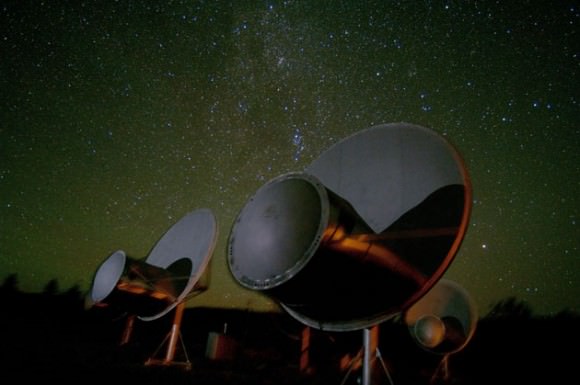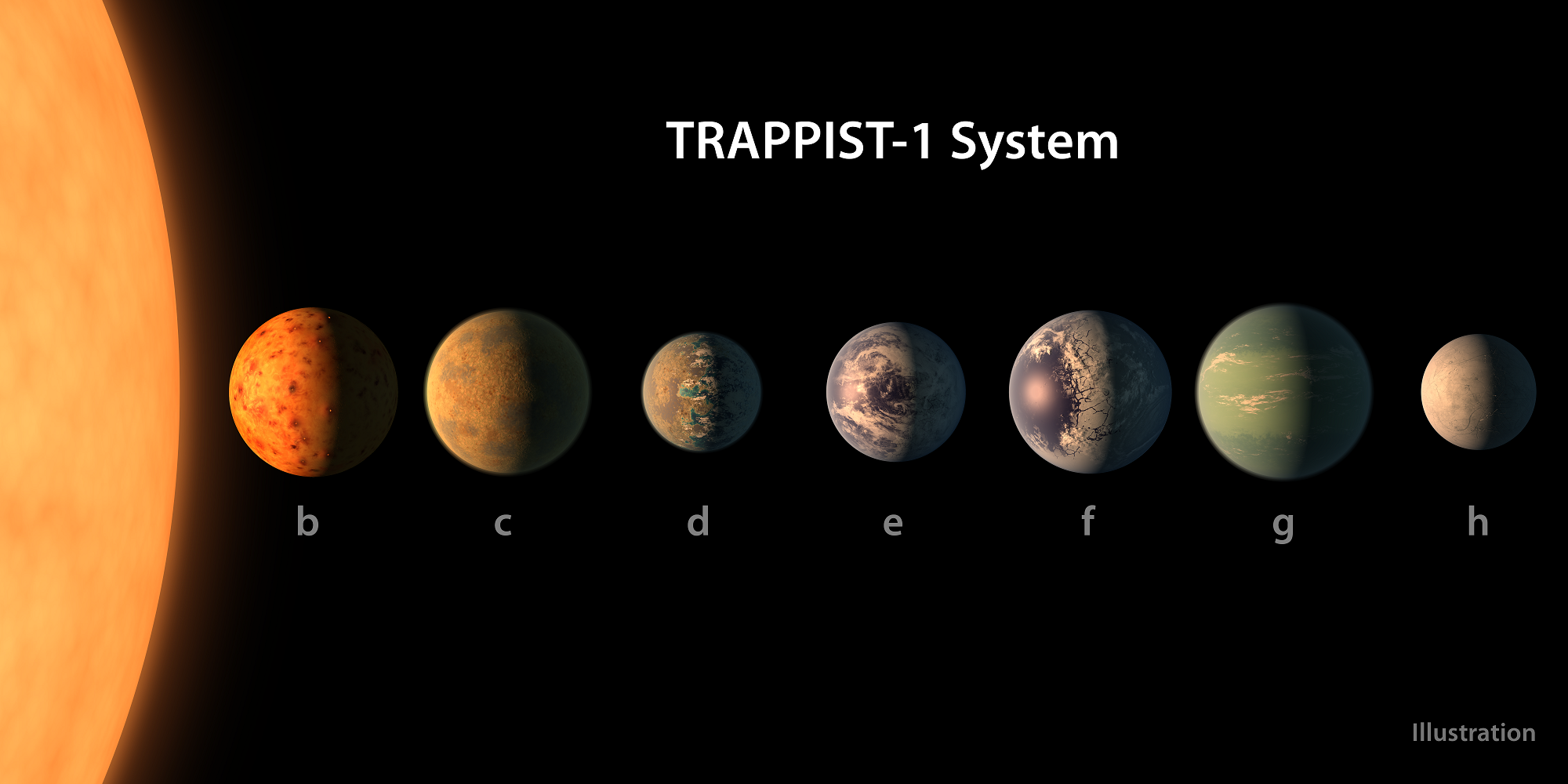The Trappist-1 system has been featured in the news quite a bit lately. In May of 2016, it appeared in the headlines after researchers announced the discovery of three exoplanets orbiting around the red dwarf star. And then there was the news earlier this week of how follow-up examinations from ground-based telescopes and the Spitzer Space Telescope revealed that there were actually seven planets in this system.
And now it seems that there is more news to be had from this star system. As it turns out, the Search for Extraterrestrial Intelligence (SETI) Institute was already monitoring this system with their Allen Telescope Array (ATA), looking for signs of life even before the multi-planet system was announced. And while the survey did not detect any telltale signs of radio traffic, further surveys are expected.
Given its proximity to our own Solar System, and the fact that this system contains seven planets that are similar in size and mass to Earth, it is both tempting and plausible to think that life could be flourishing in the TRAPPIST-1 system. As Seth Shostak, a Senior Astronomer at SETI, explained:
“[T]he opportunities for life in the Trappist 1 system make our own solar system look fourth-rate. And if even a single planet eventually produced technically competent beings, that species could quickly disperse its kind to all the rest… Typical travel time between worlds in the Trappist 1 system, even assuming rockets no speedier than those built by NASA, would be pleasantly short. Our best spacecraft could take you to Mars in 6 months. To shuttle between neighboring Trappist planets would be a weekend junket.”

Little wonder then why SETI has been using their Allen Telescope Array to monitor the system ever since exoplanets were first announced there. Located at the Hat Creek Radio Observatory in northern California (northeast of San Francisco), the ATA is what is known as a “Large Number of Small Dishes” (LNSD) array – which is a new trend in radio astronomy.
Like other LNSD arrays – such as the proposed Square Kilometer Array currently being built in Australia and South Africa – the concept calls for the deployment of many smaller dishes over a large surface area, rather than a single large dish. Plans for the array began back in 1997, when the SETI Institute convened a workshop to discuss the future of the Institute and its search strategies.
The final report of the workshop, titled “SETI 2020“, laid out a plan for the creation of a new telescope array. This array was referred to as the One Hectare Telescope at the time, since the plan called for a LNSD encompassing an area measuring 10,000 m² (one hectare). The SETI Institute began developing the project in conjunction with the Radio Astronomy Laboratory (RAL) at the UC Berkeley.
In 2001, they secured a $11.5 million donation from the Paul G. Allen Family Foundation, which was established by Microsoft co-founder Paul Allen. In 2007, the first phase of construction was completed and the ATA finally became operational on October 11th, 2007, with 42 antennas (ATA-42). Since that time, Allen has committed to an additional $13.5 million in funding for a second phase of expansion (hence why it bears his name).

Compared to large, single dish-arrays, smaller dish-arrays are more cost-effective because they can be upgraded simply by adding more dishes. The ATA is also less expensive since it relies on commercial technology originally developed for the television market, as well as receiver and cryogenic technologies developed for radio communication and cell phones.
It also uses programmable chips and software for signal processing, which allows for rapid integration whenever new technology becomes available. As such, the array is well suited to running simultaneous surveys at centimeter wavelengths. As of 2016, the SETI Institute has performed observations with the ATA for 12 hour periods (from 6 pm and 6 am), seven days a week.
And last year, the array was aimed towards TRAPPIST-1, where it conducted a survey scanning ten billion radio channels in search of signals. Naturally, the idea that a radio signal would be emanating from this system, and one which the ATA could pick up, might seem like a bit of a longshot. But in fact, both the infrastructure and energy requirements would not be beyond a species who’s technical advancement is commensurate with our own.
“Assuming that the putative inhabitants of this solar system can use a transmitting antenna as large as the 500 meter FAST radio telescope in China to beam their messages our way, then the Allen Array could have found a signal if the aliens use a transmitter with 100 kilowatts of power or more,” said Shostak. “This is only about ten times as energetic as the radar down at your local airport.”

So far, nothing has been picked up from this crowded system. But the SETI Institute is not finished and future surveys are already in the works. If there is a thriving, technologically-advanced civilization in this system (and they know their way around a radio antenna), surely there will be signs soon enough.
And regardless, the discovery of seven planets in the TRAPPIST-1 system is very exciting because it demonstrates just how plentiful systems that could support life are in our Universe. Not only does this system have three planets orbiting within its habitable zone (all of which are similar in size and mass to Earth), but the fact that they orbit a red dwarf star is very encouraging.
These stars are the most common in our Universe, making up 70% of stars in our galaxy, and up to 90% in elliptical galaxies. They are also very stable, remaining in their Main Sequence phase for up to 10 trillion years. Last, but not least, astronomers believe that 20 out of 30 nearest stars to our Solar System are red dwarfs. Lots of opportunities to find life within a few dozen light years!
“[W]hether or not Trappist 1 has inhabitants, its discovery has underlined the growing conviction that the Universe is replete with real estate on which biology could both arise and flourish,’ says Shostak. “If you still think the rest of the universe is sterile, you are surely singular, and probably wrong.”
Further Reading: SETI


The Solar System with Earth-Moon arrangement 😉 is quite unique, and therefore we have to look for a solar system with a planet similar in make-up, in the habitable zone, and a Moon about 1/3 the size of the planet rotating around that world… still then. there will be a million things to fall into place to allow for a similar development scenario as Earth`s.
That is why I believe the Drake-Equation to be way to optimistic, well, just wishful thinking.
Maybe homo sapiens sapiens has already had several chances in the past couple million years and blew it, just like we are blowing it now.
Jeez, I wish I could just go where no one has gone before, now… 😉
The Trappist-1 system is only 1 billion years old, so it would probably be premature for a homegrown civilization. If another star-faring species has colonized it, they probably do not use frequencies that we are familiar with.
Because of tidal locking and red dwarf flaring, K class stars are probably our best choices for nearby stars to investigate. Then G and less flaring prone M class stars.
Actually the star is 500 million years old. So the planets are even younger. Its odd that Shostak would think there maybe intelligent aliens there with radio. The planets might not even cooled off from the baking oven as yet. Or do such cool star systems have a shorter timeline for formation?
“To search expectantly for a radio signal from an extraterrestrial source is probably as culture-bound a presumption as to search the galaxy for a good Italian restaurant.” – Terence McKenna
If “they” are listening to us, they’re getting familiar with brand new episodes of Laverne & Shirley, Archie Bunker and the six million dollar man ….
Try listening to trumpist. 😀
For a long time now, I’ve been a SETI@home participant. Not that I expect the project to “find ET.” For starters, even if I or someone else did scan a signal that proved intelligent life existed elsewhere, I think the government would step into the picture and “sit” on the news – and possibly use nefarious means to damage the reputations of people who said ET existed (or in some other way, shut them up). So, when SETI says, “No, we haven’t communicated with an alien intelligence,” who can say if they’re being honest?
One other thing. Assuming extraterrestrial civilizations do exist, who can say they’d be benevolent? Earth history is replete with multiple examples of one group of people beating the heck out of another group of people and taking their land. Scientific achievement does not guarantee benevolence. While our signals might signify intelligence, they could also signify “weakness” to a more advanced civilization … weakness upon which an advanced civilization might want to capitalize for their “own” benefit. And such a civilization might not want to “telegraph their punch” by responding to us … while they prepare for invasion & conquest.
But, there’s always a 50/50 chance an extraterrestrial civilization “could” be benevolent. And the possibility of contact with such a benevolent civilization is the only thing that keeps me participating in SETI@home. May the odds be ever in our favor.